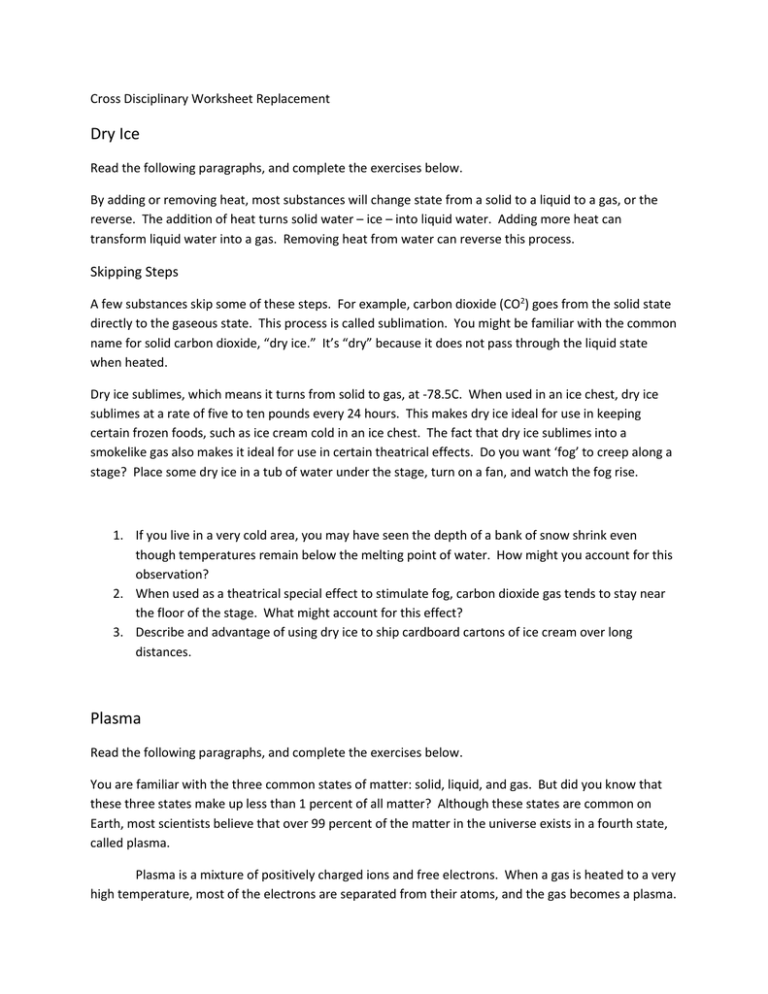Cross Disciplinary Worksheet Replacement Dry Ice Read the
advertisement

Cross Disciplinary Worksheet Replacement Dry Ice Read the following paragraphs, and complete the exercises below. By adding or removing heat, most substances will change state from a solid to a liquid to a gas, or the reverse. The addition of heat turns solid water – ice – into liquid water. Adding more heat can transform liquid water into a gas. Removing heat from water can reverse this process. Skipping Steps A few substances skip some of these steps. For example, carbon dioxide (CO2) goes from the solid state directly to the gaseous state. This process is called sublimation. You might be familiar with the common name for solid carbon dioxide, “dry ice.” It’s “dry” because it does not pass through the liquid state when heated. Dry ice sublimes, which means it turns from solid to gas, at -78.5C. When used in an ice chest, dry ice sublimes at a rate of five to ten pounds every 24 hours. This makes dry ice ideal for use in keeping certain frozen foods, such as ice cream cold in an ice chest. The fact that dry ice sublimes into a smokelike gas also makes it ideal for use in certain theatrical effects. Do you want ‘fog’ to creep along a stage? Place some dry ice in a tub of water under the stage, turn on a fan, and watch the fog rise. 1. If you live in a very cold area, you may have seen the depth of a bank of snow shrink even though temperatures remain below the melting point of water. How might you account for this observation? 2. When used as a theatrical special effect to stimulate fog, carbon dioxide gas tends to stay near the floor of the stage. What might account for this effect? 3. Describe and advantage of using dry ice to ship cardboard cartons of ice cream over long distances. Plasma Read the following paragraphs, and complete the exercises below. You are familiar with the three common states of matter: solid, liquid, and gas. But did you know that these three states make up less than 1 percent of all matter? Although these states are common on Earth, most scientists believe that over 99 percent of the matter in the universe exists in a fourth state, called plasma. Plasma is a mixture of positively charged ions and free electrons. When a gas is heated to a very high temperature, most of the electrons are separated from their atoms, and the gas becomes a plasma. Plasma is considered to be a fourth state of matter because its properties are different from those of solids, liquids, or gases. Where Plasma is Found Why is there so much plasma in the universe? The interiors of stars, including the sun, contain hot, dense plasmas. Stars are far more numerous that other types of celestial bodies such as planets. In addition, the space between stars contains plasma, although it is much less dense than the plasma found within stars. Plasma is not as common on Earth, but it does exist. In fact, the glowing gas inside a neon sign is plasma. Rarer but more spectacular examples of plasma are the flickering, colorful bands of light sometimes seen in the sky near Earth’s poles. These displays, known as the aurora borealis (in the north) and the aurora australis (in the south), occur when plasma from the sun encounters Earth’s magnetic field. 1. Describe what plasma is, and name three examples of plasmas. 2. How can plasma be the most common state of matter, since most matter we observe is either a solid, a liquid, or a gas? 3. How is plasma different enough from a gas to be called a fourth state of matter?








